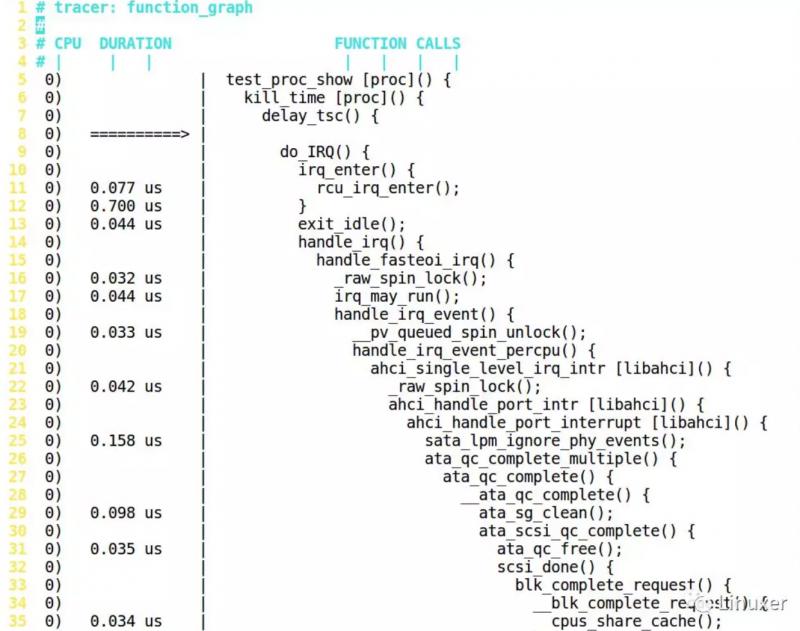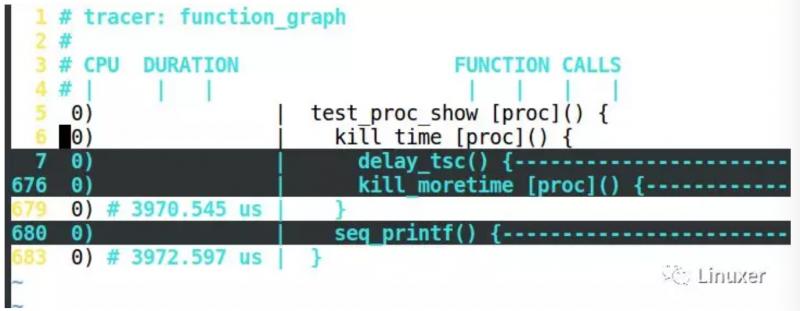宋宝华:关于Ftrace的一个完整案例
- 2019 年 11 月 7 日
- 筆記
本文系转载,著作权归作者所有。商业转载请联系作者获得授权,非商业转载请注明出处。
作者: 宋宝华
来源: 微信公众号linux阅码场(id: linuxdev)

Ftrace简介
Ftrace是Linux进行代码级实践分析最有效的工具之一,比如我们进行一个系统调用,出来的时间过长,我们想知道时间花哪里去了,利用Ftrace就可以追踪到一级级的时间分布。
Ftrace案例
写一个proc模块,包含一个proc的读和写的入口。test_proc_show()故意调用了一个kill_time()的函数,而kill_time()的函数,又调用了mdelay(2)和kill_moretime()的函数,该函数体内调用mdelay(2)。
kill_time()的函数和kill_moretime()函数前面都加了noinline以避免被编译器inline优化掉。
#include <linux/module.h> #include <linux/kernel.h> #include <linux/init.h> #include <linux/version.h> #include <linux/proc_fs.h> #include <linux/seq_file.h> #include <linux/delay.h> #include <linux/uaccess.h>
static unsigned int variable; static struct proc_dir_entry *test_dir, *test_entry;
static noinline void kill_moretime(void) { mdelay(2); }
static noinline void kill_time(void) { mdelay(2); kill_moretime(); }
static int test_proc_show(struct seq_file *seq, void *v) { unsigned int *ptr_var = seq->private; kill_time(); seq_printf(seq, "%un", *ptr_var); return 0; }
static ssize_t test_proc_write(struct file *file, const char __user *buffer, size_t count, loff_t *ppos) { struct seq_file *seq = file->private_data; unsigned int *ptr_var = seq->private; int err; char *kbuffer;
if (!buffer || count > PAGE_SIZE - 1) return -EINVAL;
kbuffer = (char *)__get_free_page(GFP_KERNEL); if (!kbuffer) return -ENOMEM;
err = -EFAULT; if (copy_from_user(kbuffer, buffer, count)) goto out; kbuffer[count] = '�';
*ptr_var = simple_strtoul(kbuffer, NULL, 10); return count;
out: free_page((unsigned long)buffer); return err; }
static int test_proc_open(struct inode *inode, struct file *file) { return single_open(file, test_proc_show, PDE_DATA(inode)); }
static const struct file_operations test_proc_fops = { .owner = THIS_MODULE, .open = test_proc_open, .read = seq_read, .write = test_proc_write, .llseek = seq_lseek, .release = single_release, };
static __init int test_proc_init(void) { test_dir = proc_mkdir("test_dir", NULL); if (test_dir) { test_entry = proc_create_data("test_rw",0666, test_dir, &test_proc_fops, &variable); if (test_entry) return 0; }
return -ENOMEM; } module_init(test_proc_init);
static __exit void test_proc_cleanup(void) { remove_proc_entry("test_rw", test_dir); remove_proc_entry("test_dir", NULL); } module_exit(test_proc_cleanup);
MODULE_AUTHOR("Barry Song <[email protected]>"); MODULE_DESCRIPTION("proc exmaple"); MODULE_LICENSE("GPL v2");模块对应的Makefile如下:
KVERS = $(shell uname -r)
# Kernel modules obj-m += proc.o
# Specify flags for the module compilation. #EXTRA_CFLAGS=-g -O0
build: kernel_modules
kernel_modules: make -C /lib/modules/$(KVERS)/build M=$(CURDIR) modules
clean: make -C /lib/modules/$(KVERS)/build M=$(CURDIR) clean编译并且加载:
$ make baohua@baohua-perf:~/develop/training/debug/ftrace/proc$ $ sudo insmod proc.ko [sudo] password for baohua: 之后/proc目录下/proc/test_dir/test_rw文件可被读写。
下面我们用Ftrace来跟踪test_proc_show()这个函数。
我们把启动ftrace的所有命令写到一个脚本function.sh里面:
#!/bin/bash
debugfs=/sys/kernel/debug echo nop > $debugfs/tracing/current_tracer echo 0 > $debugfs/tracing/tracing_on echo $$ > $debugfs/tracing/set_ftrace_pid echo function_graph > $debugfs/tracing/current_tracer #replace test_proc_show by your function name echo test_proc_show > $debugfs/tracing/set_graph_function echo 1 > $debugfs/tracing/tracing_on exec "$@"然后用这个脚本去启动cat /proc/test_dir/test_rw,这样ftrace下面test_proc_show()函数就被trace了。
# ./function.sh cat /proc/test_dir/test_rw 0读取trace的结果:
# cat /sys/kernel/debug/tracing/trace > 1
接着用vim打开这个文件1,发现这个文件有600多行:


长到看不清!!
Ftrace结果怎么读?
Ftrace结果怎么读?答案非常简单:如果是叶子函数,就直接在这个函数的前面显示它占用的时间,如果是非叶子,要等到 }的时候,再显示时间,如下图:

延迟比较大的部分,会有+、#等特殊标号:
'$' - greater than 1 second '@' - greater than 100 milisecond '*' - greater than 10 milisecond '#' - greater than 1000 microsecond '!' - greater than 100 microsecond '+' - greater than 10 microsecond ' ' - less than or equal to 10 microsecond.## vim对Ftrace进行折叠
上面那个Ftrace文件太大了,大到看不清。我们可以用vim来折叠之,不过需要一个vim的特别配置,我把它存放在了我的~目录,名字叫.fungraph-vim:
" Enable folding for ftrace function_graph traces. " " To use, :source this file while viewing a function_graph trace, or use vim's " -S option to load from the command-line together with a trace. You can then " use the usual vim fold commands, such as "za", to open and close nested " functions. While closed, a fold will show the total time taken for a call, " as would normally appear on the line with the closing brace. Folded " functions will not include finish_task_switch(), so folding should remain " relatively sane even through a context switch. " " Note that this will almost certainly only work well with a " single-CPU trace (e.g. trace-cmd report --cpu 1).
function! FunctionGraphFoldExpr(lnum) let line = getline(a:lnum) if line[-1:] == '{' if line =~ 'finish_task_switch() {$' return '>1' endif return 'a1' elseif line[-1:] == '}' return 's1' else return '=' endif endfunction
function! FunctionGraphFoldText() let s = split(getline(v:foldstart), '|', 1) if getline(v:foldend+1) =~ 'finish_task_switch() {$' let s[2] = ' task switch ' else let e = split(getline(v:foldend), '|', 1) let s[2] = e[2] endif return join(s, '|') endfunction
setlocal foldexpr=FunctionGraphFoldExpr(v:lnum) setlocal foldtext=FunctionGraphFoldText() setlocal foldcolumn=12 setlocal foldmethod=expr之后我们配置vim为这个模板来打开前面那个600多行的文件1:
vim -S ~/.fungraph-vim 1
这样我们看到的样子是:

我们可以把光标移动到第5行,键盘敲打za,则展开为:

继续展开第6行的kill_time(),按za:

我们可以用z、a两个按键,搜索或者展开Ftrace的结果。

最后,https://github.com/brendangregg/perf-tools 对Ftrace的功能进行了很好的封装和集成,建议大家用perf-tools来使用Ftrace,则效果更佳更简单。
有空再聊perf-tools。
更多精彩更新中……欢迎关注微信公众号:linux阅码场(id: linuxdev)
